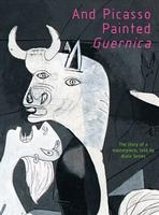And Picasso painted Guernica by Alain Serres

Allen and Unwin, 2010. ISBN 978171759945.
Highly recommended. The Spanish Civil War (1936 -1939) is often seen
historically as a
practice for World War Two as German and Italian forces tried out their
armoury and pushed other European powers to see how far they could go.
The world watched appalled as Guernica, the Basque town in the province
of Biscay and a centre for republican forces fighting against General
Franco, was bombed: the first time a civilian population was targetted
by opposing forces. On April 26, 1937, market day, Germany's Condor
Legion of the Luftwaffe and the Italian Fascist Aviazione Legionaria
dropped enough bombs to kill 1,600 people and devastate the town, in a
tactic now known as terror or carpet bombing.
Artists responded in the way they knew best, and for Picasso, his
unashamed anger resulted in the world famous canvas, Guernica. A level
of the hatred he felt for the Fascists, saw his painting Guernica,
taken to New York in 1939, only to be returned and hung in Madrid on
Franco's death in 1981. This painting along with his other work was
branded as degenerate by the Nazis and he was forbidden to exhibit
during their occupation of France, 1939-1945.
This astonishing book gives the reader an intrepid close up view of the
painting and its imagery and style, the painter and the world in which
he lived. Born in 1881, a world so different from the one in which we
inhabit, Picasso's father, an art teacher, gave up painting when he
became aware of his son's talents at age 13. Serres gives us a peep
into the world of this boy born when Edison first produced a light
bulb, taking over his father's brushes at a time when the first
underground railway was built in Paris, developing his own style during
the horrors of World War 1.
But it is April 1937 that galvanizes him into action when terror
bombing
lays Guernica bare. In his studio in Paris, he reuses ideas first
developed for the etchings he made decrying General Franco several
years before, he adds the imagery of Spain, the bulls and horses of his
past, the legends of old, and draws and tries out ideas until at the
end of May, he is ready to start. Using a huge canvas, 7 metres in
length, he spends the next two days and nights on his work, sketching
in the outline. Using blacks and whites and greys, underlining the
horror and brutality of it all, he works until he puts down his brushes
in early June.
Serres shows the reader what each symbol means, why Picasso used the
images that he did. He points out the dove of peace, almost hidden in
one corner, and the women holding a lamp, lighting the horror to the
world. A double page in the centre of the book has fold out pages,
giving a 4 page spread on which to view Guernica in a larger format,
and several times, the painting is shown in a photograph with people,
giving a terrific idea of just how big it really is.
The precision with which Serres describes the painting, its style and
images makes it memorable. Students will love to look for different
things in the painting as the teacher or their group read the book,
they will marvel at Picasso's background and the detail which Serres
gives, grounding Picasso into a set time and place, and above all they
will appreciate the labour he took to show the horror of Guernica to
the world.
The last few pages of the book show some of the work Picasso did
following 1945, and allude to his impact on the art world. But the
focus of the book, Guernica, cannot be overlooked, as this painting is
seen as a fearless monument to the cruelty of war, and a beacon for
peace. The end papers show how images of the painting are used to
promote peace around the world today.
An astute teacher will have a large map of Europe and Spain at the
ready to point out where the places mentioned in the text are situated.
Whether it is an art class, work about war or peace in the classroom,
this book is an invaluable support, one that could be used across the
board in all spheres of education, acquainting children with Picasso
and this famous painting or whetting their appetites to research further.
Fran Knight